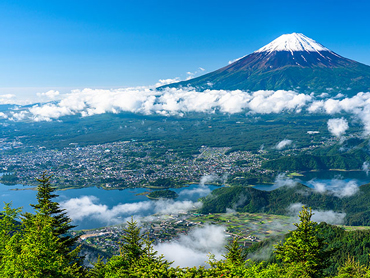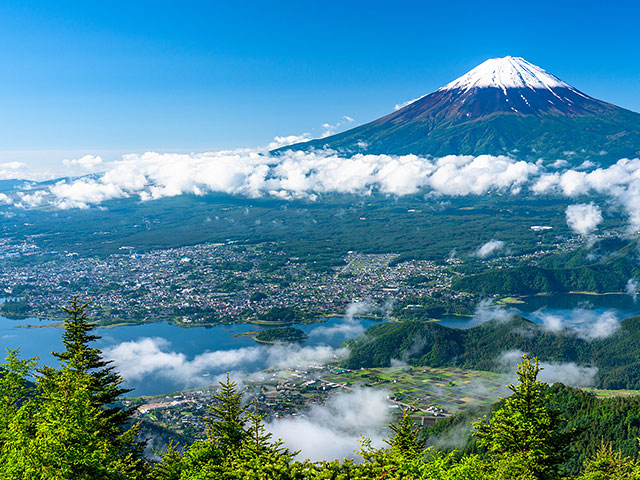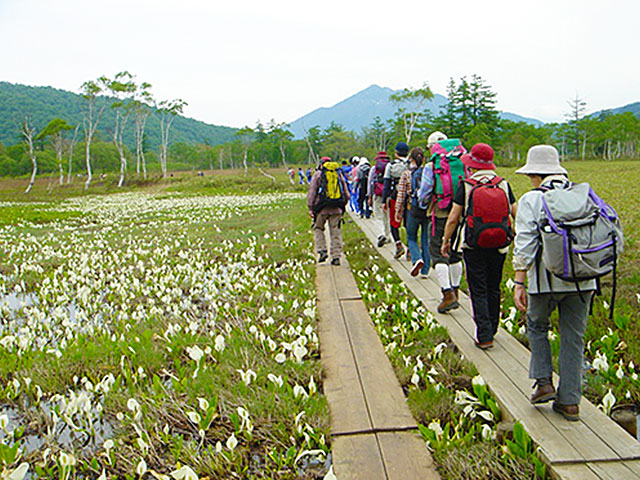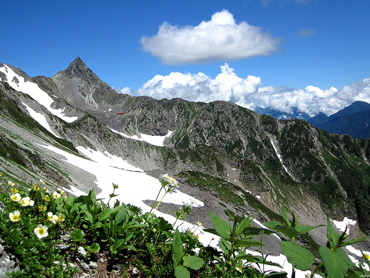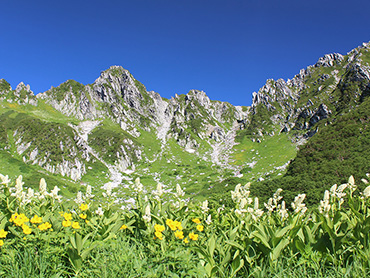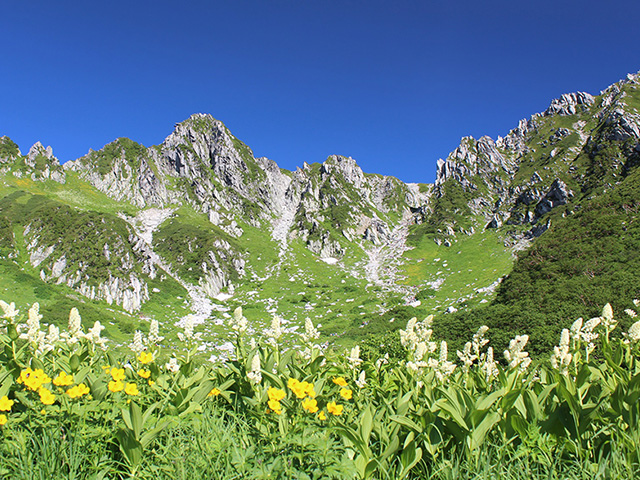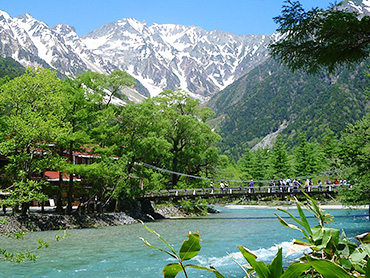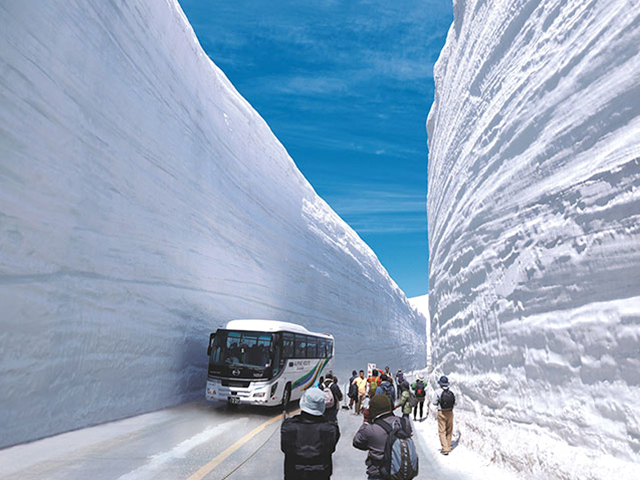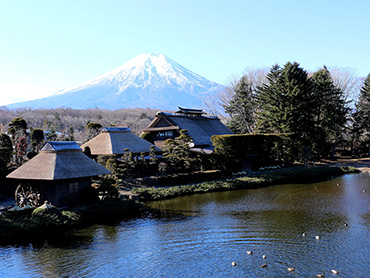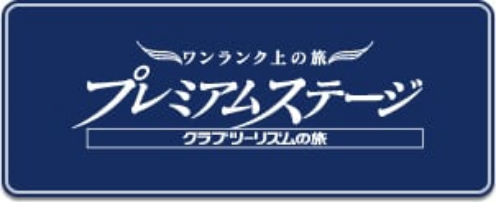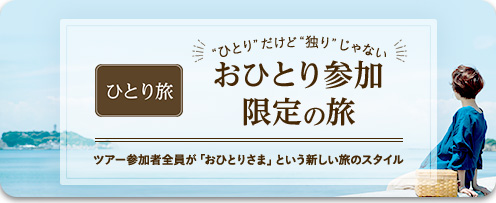
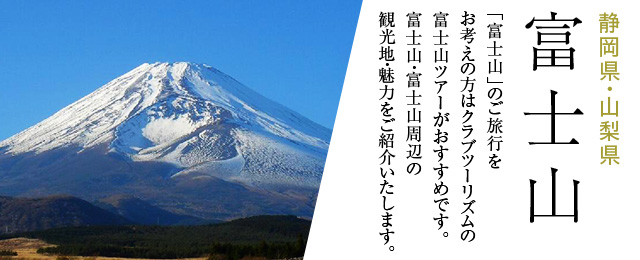
If you are going on a tour or trip to climb Mt. Fuji, hike, or go sightseeing in the surrounding area, leave it to Club Tourism! Our tours are accompanied by a tour guide, so you can feel safe and comfortable. We have plenty of options, from train, bus, and plane tours to Themed Travel such as climbing, hiking, and photography! Searching and booking tours is easy.
Let's visit the constituent assets and tourist sites of Mt. Fuji
View the components on a map
Mount Fuji has finally been recognized as a World Heritage Site.
"World Bunka" is a treaty that protects ruins, architecture, and other sites that have universal cultural value and that we wish to pass on to future generations.
Fujiyama was added to the list in recognition of its long-standing religious roots and its influence among the Japanese people through art such as paintings.
The following "constituent assets" of Fujiyama are registered as World Bunka Sites.

-
Fujisan Hongu Sengen-taisha Shrine
-
Yamamiya Sengen Shrine
-
Murayama Sengen Shrine
-
Suyama Sengen Shrine
-
Fuji Sengen Shrine (Subashiri Sengen Shrine)
-
Hitoana Fujiko Site
-
Shiraito Falls
-
Miho no Matsubara
-
Kita-guchi Hongu Fuji Sengen Shrine
-
Kawaguchi Asama Shrine
-
Fuji Omuro Sengen Shrine
-
Oshi Residence (former Togawa family residence)
-
Oshi Residence (Osano family residence)
-
West Lake
-
Lake Shoji
-
Lake Motosu
-
Lake Yamanaka
-
Lake Kawaguchi
-
Funatsu Tainai Jukei
-
Yoshida Tainai Jukei (not open to the public)
-
Mount Fuji Fifth Station
"Assets Composition" of Mount Fuji in Shizuoka-ken
*The image is Image
Fujisan Hongu Sengen-taisha Shrine
Fujisan Hongu Sengen Taisha Shrine, located in Fujinomiya City, Shizuoka Prefecture, is the head shrine of the approximately 1,300 Sengen shrines across the country. It is sometimes abbreviated to Sengen Taisha.
Yamamiya Sengen Shrine
Yamamiya Sengen Shrine in Fujinomiya City, Shizuoka Prefecture is one of the Sengen shrines found throughout Japan. It is also a ritual site for Fuji worship, and is thought to be the oldest of the approximately 1,300 Sengen shrines in Japan.
Murayama Sengen Shrine
Murayama Sengen Shrine in Murayama, Fujinomiya City, Shizuoka Prefecture, is the center of Shugendo on Mount Fuji. It is said that a temple called Kohoji was located here until it was abolished during the anti-Buddhist movement in the Meiji era.
Suyama Sengen Shrine
Suyama Sengen Shrine in Susono City, Shizuoka Prefecture, is one of the Sengen Shrines located at the Suyamaguchi entrance, which was formerly called "Shuzan."
Fuji Sengen Shrine (Subashiri Sengen Shrine)
Higashiguchi Hongu Fuji Sengen Shrine, located in Subashiri, Oyama-cho, Sunto-gun, Shizuoka Prefecture, is one of the Sengen shrines found throughout Japan. It is located at the starting point of the Subashiriguchi trail to Mount Fuji. Its official name is Fuji Sengen Shrine, but it is also called Subashiri Sengen Shrine.
Hitoana Fujiko Site

(Image)
The Hitoana Fujiko Site in Fujinomiya City, Shizuoka Prefecture, is a historic site designated by the city. The Hitoana Fujiko Site is located within the grounds of Hitoana Sengen Shrine, and contains the Hitoana lava cave, an approximately 83-meter long cave formed within the Inusuzumiyama lava flow.
*There are currently no tours available.
Shiraito Falls

(Image)
Shiraito Falls in Fujinomiya City, Shizuoka Prefecture, is one of the 100 best waterfalls in Japan. The neighboring Otodome Falls is also one of them. It has also been designated as a national scenic spot and natural monument.
Miho no Matsubara

(Image)
Miho no Matsubara, located on the Miho Peninsula in Shimizu Ward, Shizuoka City, Shizuoka Prefecture, is a scenic spot that is considered one of the New Three Most Viewed Places in Japan and one of the Three Great Pine Groves of Japan. It has also been designated as one of Japan's 100 Best White Sand and Green Pine Forests, and has been registered as a World Heritage Site.
You can also search for tours to tourist spots in Shizuoka Prefecture!
"Assets Composition" of Mount Fuji in Yamanashi-ken
*The image is Image
Kita-guchi Hongu Fuji Sengen Shrine
Kita-guchi Hongu Fuji Sengen Shrine, located in Yamanashi-ken Fujiyoshida-shi, has a history of over 1,900 years and is a shrine at the entrance to the Mount Fuji climbing trails.
Kawaguchi Asama Shrine
Kawaguchi Asama Shrine, located in Yamanashi-ken Minamitsuru-gun Fujikawaguchiko-machi, is one of the Asama Shrines found throughout Japan. The towering cedar trees along the approach to the shrine are truly impressive.
Fuji Omuro Sengen Shrine
Fuji Fuji Omuro Sengen Shrine, located in Yamanashi-ken Minamitsuru-gun Fujikawaguchiko-machi Fujiyama Prefecture, is the oldest shrine on Kawaguchi Kohan and is the first shrine to be enshrined Fuji Yamanaka.
Oshi Residence (former Togawa family residence)

(Image)
Yamanashi The Oshi Residence (formerly the Sotogawa Family Residence) in Fujiyoshida City, Fujiyoshida Prefecture, is the home of the Oshi who supported the faith of Mt.
Oshi Residence (Osano family residence)
Yamanashi The Osano Family Residence (Osanoke Jutaku), located in Fujiyoshida City, Fujiyoshida Prefecture, is the home of the Oshi, a family of priests who supported the worship of Mt. The Osano family has been a family of oshi (priests) belonging to the Kitaguchi Hongu Fuji Sengen Shrine for generations.
*Not open to the public: A replica of the house is available at the Museum of History and Folklore, Fujiyoshida City.
West Lake

(Image)
Yamanashi Fuji Lake Kawaguchi town in Minamitsuru-gun, Fuji Prefecture, is one of the five lakes of Mt. Fuji Lake Kawaguchi It is located near the center of the town. It is the fourth largest of the Fuji Five Lakes in terms of area.
Lake Shoji

(Image)
Lake Shojiko, located in Lake Kawaguchi Town, Minamitsuru District, Yamanashi Prefecture, is one of the Fuji Five Lakes. It is a dammed lake formed by volcanic activity of Mt. Fuji. It is the smallest lake among the five lakes.
Lake Motosu

(Image)
Yamanashi Lake Motosuko is one of the Five Lakes of Fuji, located in Minami-Tsuru-gun, Fuji Lake Kawaguchi Town, and Minobu Town, Minamikoma-gun. It is the westernmost of the five lakes.
Lake Yamanaka

(Image)
Yamanashi Lake Yamanaka, located in Yamanakako Village, Minamitsuru District, is the southeasternmost of the Fuji Five Lakes scattered at the northern foot of Fuji. It is also the source of the Sagami River.
Lake Yamanaka and Mt. Fuji / Photograph taken by the customer: Ikuo Yakushi's work in Kanagawa Prefecture
Lake Kawaguchi

(Image)
Lake Kawaguchi Kawaguchiko, located in Lake Kawaguchi Town, Minamitsuru District, Yamanashi Prefecture, has the longest shoreline and is located at the lowest altitude of all the Fuji Five Lakes.
Lake Kawaguchi and Mt. Fuji / Photo taken by a customer: Work by Sadao Matsui from Osaka Prefecture
Funatsu Tainai Jukei

(Image)
Funatsu Tainai Jukei, located in Fujikawaguchiko-machi, Lake Kawaguchi gun, Yamanashi Prefecture, is a cave (lava tree mold) where lava flowing from Mt. Fuji solidified while surrounding a tree, leaving the tree as a mold in the lava flow. Konohana Sakuya-hime, the deity of Mt. Fuji, is enshrined in the cave. Many people visit to pray for safe childbirth.
Yoshida Tainai Jukei (not open to the public)
Yoshida Tainai Jukei (not open to the public) in Yamanashi-ken Fujiyoshida-shi Kamiyoshida, are lava tree molds located on the eastern edge of the Maruo lava flow. At Yoshida Tainai Shrine, located in Tainai Tree Molds, a "Tainai Festival" is held once a year. In Fujiyama faith, it is said that by entering Tainai and then coming out, one is reborn.
Mount Fuji Fifth Station

(Image)
The Mount Fuji Fifth Station is the starting point for climbing Mount Fuji and is known as the boundary between heaven and earth.It is located at an elevation of 2,305 meters. From the Fifth Station parking lot, you can enjoy views of Lake Yamanaka, Fujiyoshida City, and Lake Kawaguchi below, and the Japanese Alps can be seen in the distance.
You can also search for tours to tourist spots in Yamanashi Prefecture!
If you are interested in Mt.Fuji, we also recommend these special features!
Customer Co-Creation Activities
Latest Tours and Information
Club Tourism Travel Brand
Overseas Travel
Club Tourism Internet Membership Information
-
A wide range of services exclusively available to members
-
Search for trips anytime, anywhere!
-
Be the first to know about the best seasonal travel deals!

